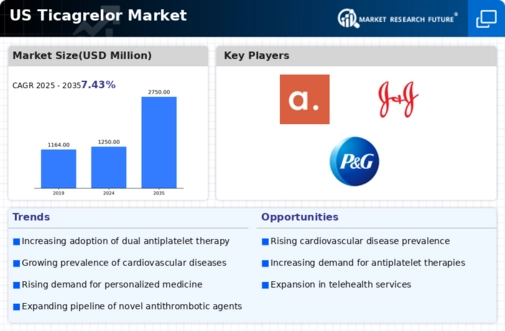Rising Healthcare Expenditure
The increasing healthcare expenditure in the US is a significant driver for the ticagrelor market. As healthcare budgets expand, there is a greater focus on investing in effective treatments for chronic conditions, particularly cardiovascular diseases. In 2025, healthcare spending in the US is projected to exceed $4 trillion, with a substantial portion allocated to pharmaceuticals. This trend suggests that healthcare providers are more likely to prescribe ticagrelor, given its proven efficacy in reducing adverse cardiovascular events. Furthermore, as insurance coverage for innovative therapies improves, patient access to ticagrelor is expected to rise, thereby enhancing its market presence. The financial commitment to improving cardiovascular health is likely to sustain the growth trajectory of the ticagrelor market.
Advancements in Clinical Research
Ongoing advancements in clinical research are significantly influencing the ticagrelor market. Numerous studies are being conducted to explore the long-term benefits and potential new indications for ticagrelor, which may expand its usage beyond traditional settings. For instance, recent trials have suggested that ticagrelor may be beneficial in patients with acute coronary syndromes, potentially increasing its market penetration. The US market for ticagrelor is anticipated to grow as new data emerges, with estimates indicating a compound annual growth rate (CAGR) of around 8% over the next five years. This research-driven approach not only enhances the understanding of ticagrelor's therapeutic potential but also encourages healthcare providers to consider it as a first-line treatment option.
Emerging Competition and Market Dynamics
The ticagrelor market is experiencing dynamic shifts due to emerging competition from new antiplatelet agents. As pharmaceutical companies invest in research and development, novel therapies are entering the market, which may challenge ticagrelor's dominance. However, the established efficacy and safety profile of ticagrelor may provide it with a competitive edge. In 2025, the market landscape is expected to become increasingly competitive, with several new entrants potentially capturing market share. This competition could lead to price adjustments and promotional strategies that may benefit consumers. Nevertheless, the established position of ticagrelor, supported by clinical guidelines, suggests that it will continue to play a vital role in the antiplatelet therapy landscape.
Regulatory Support for Innovative Therapies
Regulatory support for innovative therapies is a pivotal driver for the ticagrelor market. The US Food and Drug Administration (FDA) has been actively promoting expedited review processes for drugs that demonstrate significant clinical benefits. This regulatory environment encourages pharmaceutical companies to invest in the development of ticagrelor and similar agents. In 2025, the FDA's commitment to facilitating access to effective treatments is likely to enhance the market for ticagrelor, as new formulations or indications may receive swift approval. The proactive stance of regulatory bodies not only fosters innovation but also ensures that patients have timely access to advanced therapies, thereby supporting the growth of the ticagrelor market.
Increasing Awareness of Antiplatelet Therapy
The growing awareness of antiplatelet therapy among healthcare professionals and patients is a crucial driver for the ticagrelor market. As cardiovascular diseases remain a leading cause of morbidity and mortality in the US, educational initiatives are emphasizing the importance of effective antiplatelet agents. This heightened awareness is likely to lead to increased prescriptions of ticagrelor, as it is recognized for its efficacy in reducing thrombotic events. In 2025, the market for antiplatelet drugs is projected to reach approximately $10 billion, with ticagrelor capturing a significant share due to its favorable safety profile and clinical outcomes. The ongoing efforts to educate both patients and providers about the benefits of ticagrelor are expected to further bolster its adoption in clinical practice.

















Leave a Comment